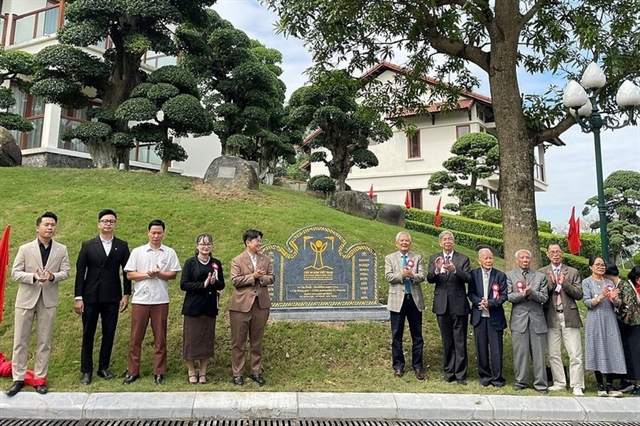 Environment
Environment

Illegal dumping of waste and building materials has become an urgent issue in the capital city of Hà Nội, concerning local residents and officials
 |
| Workers from Hà Nội Urban Environment Co Ltd collect waste which is dumping illegally along Thăng Long Avenue. Nearly 3,000 tonnes of waste were discharged at the avenue last year. — VNA/VNS Photo Mạnh Khánh |
HÀ NỘI — Illegal dumping of waste and building materials has become an urgent issue in the capital city of Hà Nội, concerning local residents and officials.
Discharging rubbish illegally takes place in many areas of the city. It is said that whenever there is unused land, waste will be dumped there illegally. This action does not only pollute the environment, affecting the city’s aesthetic beauty, but also threatens traffic safety, Vietnam News Agency reported.
Vũ Thi Liên, who lives in Hà Đông District’s Kiến Hưng Ward, told Việt Nam News that the illegal dumping of waste often took place at night, between 9pm and 4am.
“Drivers usually operate cars which carry soil and construction waste at high speed. They stop and discharge waste in just a moment and then ran away,” she said, adding that it was impossible for local residents to inform competent agencies to deal with the matter in time.
Nguyễn Thái Hùng, another resident, said he felt displeased as he saw piles of waste along the road to his house.
“At first, it’s just a small dumping site. However, in time, more and more people discharge waste, it turns into a mountain," he said, adding that he sometimes had no choice but to drive on the pavement.
A trader who used to engage in illegal dumping activity and has since retired said that whenever receiving a garbage dumping contract, they usually take charge of transporting and choosing locations of dumping at the same time, ensuring that garbage is transferred as quickly as possible.
Normally, there would be a group of people working together. Each person is assigned to take over one duty. First, they load the waste into vehicles and hide it in a suitable place. Then, some persons would ride their motorbikes to inspect the dumping sites which meet the requirements that facilitate the transportation of cars and are easy to escape from if detected. After feeling secure, they would transport the waste to the sites. They earned between VNĐ3-7 million (US$130-304) depending on the quantity and kind of rubbish per dump.
The dumping sites were also changed regularly to avoid detection, he said.
The fact that the activity occurs at night and is conducted in a “professional” way makes it difficult for competent agencies to discover and settle it.
For example, only after following an incident for a week did the environmental police from Nam Từ Liêm District catch red handed a truck discharging waste illegally in Đại Mỗ Ward.
Another truck was caught by Hà Nội Police while dumping construction waste in Hoài Đức District after keeping close watch for many days.
According to Trần Văn Khải from Hà Nội Urban Environment Co Ltd, nearly 3,000 tonnes of waste was discharged illegally along Thăng Long Avenue last year.
He said the illegal dumping of waste affected the city’s aesthetic beauty, traffic safety as well as the city’s budget as it costs much money to clean up waste.
“We [the company] have spent over VNĐ500 million ($21,800) to tidy up waste along the route which was once considered the most beautiful one in the city,” he said.
The incident was also reported in Hoài Đức District, a suburban area with much unoccupied land.
Piles of waste can easily be seen at An Thượng and Song Phương communes.
Local authorities have erected “no waste dumping’ signs and barbed wire to prevent cars from discharging rubbish. However, the efforts failed to produce the desired effect. Once violators were hindered at one site, they would seek to dump waste at the other one.
Nguyễn Đức Khoa, chairman of Song Phương Commune’s People’s Committee, acknowledged local authorities have so far failed put an end to the incident.
The communal police force has just 10 people while the Thăng Long avenue section passing through the commune is more than 2km long, he said.
Hoàng Mai District is also one of the "hotspots" for rubbish dumping. The most popular areas where waste is discharged include under Thanh Trì Bridge, and the Nguyễn Khoái dyke and along the Lừ River in Đại Kim District.
The illegal dumping of waste occurs widely in Hà Nội despite the fact the city has issued penalties for those caught illegally dumping waste since 2010.
Under the rules, people who illegally transport solid waste could face fines of up to VNĐ10-15 million ($439-658), while those caught littering on city streets with solid waste could be fined VNĐ5-10 million ($219 -439).
Solutions
According to the municipal Department of Construction, as many as 3,000 tonnes of solid construction waste are discharged every day in the city.
While construction waste from demolished works could be recycled as it has economic value, others like bricks and concrete are transported to landfills for burial. However, most of them are discharged illegally, polluting the environment.
Nguyễn Mạnh Hùng, head of the Technical Infrastructure Division under the Hà Nội Construction Department, blamed the illegal dumping of waste on low awareness on environmental protection regulations and a lack of responsibility of waste owners and waste collecting units.
Over the past few years, the city authority has set up four construction waste collection points in Thanh Trì, Đông Anh and Hoài Đức districts, as well as four transit sites which can recycle construction waste. However, it failed to meet the demand of households or project developers.
To put an end to the above-mentioned issue, Hùng suggested the city authority to speed up investment in building of a waste treatment plant.
Strict fines should be imposed with a view to discourage people from discharging waste in the public areas.
It is necessary to tighten regulations which stipulate that investors and contractors must sign contracts with waste collecting units, he said. — VNS




